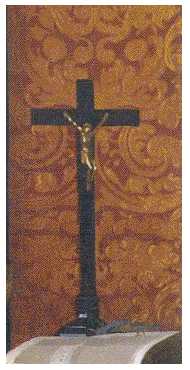Vermeer's Interfaith marriage
 Vermeer,
born in a protestant family, likely converted to the Roman Catholic religion
when marrying Catherina Bolnes, daughter of the wealthy Maria Thins, who was
from a Roman catholic background. Thus in a strict sense their family became
a Catholic one and not an interfaith one. The question is what the normal procedure
was for conversion and whether Vermeer did get enough time. In naming
their children a distinct Roman catholic flavour is clearly visible and
one painting, the Allegory of Faith (Metropolitan, NYC) Vermeer's "only
artistic mistake", was painted for a Roman Catholic patron. Apart from this
one there is no Roman catholic flavour at all...
Vermeer,
born in a protestant family, likely converted to the Roman Catholic religion
when marrying Catherina Bolnes, daughter of the wealthy Maria Thins, who was
from a Roman catholic background. Thus in a strict sense their family became
a Catholic one and not an interfaith one. The question is what the normal procedure
was for conversion and whether Vermeer did get enough time. In naming
their children a distinct Roman catholic flavour is clearly visible and
one painting, the Allegory of Faith (Metropolitan, NYC) Vermeer's "only
artistic mistake", was painted for a Roman Catholic patron. Apart from this
one there is no Roman catholic flavour at all...
Mixed marriages were a constant subject of discussion and worry
for the civil and religious authorities in the seventeenth century
Dutch Republic. In the Republic the Dutch Reformed Church had a
preferred status, and the Roman Catholic church was tolerated if it
kept out of the public eye, maintaining quiet low profile gatherings
held in hidden churches and paying the town authorities some good
annual cash. Protestant clergy knew that they would alienate people
if rules in interfaith marriages were enforced too strictly. They
balanced their situation, calculated their theoretical loss and gain
and ended up with a fair amount of toleration.
In the Vermeer house there was a crucifix
and a painting of Mary, household
objects belonging to the catholic sphere.
Dr. Ben Kaplan studied interfaith marriages in seventeenth century
Dutch Republic as an index or symptom or cause of toleration. he
found that percentages remained as low as 1 to 4 %. Higher figures,
up to 10 to 15% were scored in garrison towns near the southern Dutch
border with Flanders which was under Spanish control.
In interfaith marriages it was sometimes mutually agreed that sons
born in the marriage would follow the faith of the father, and
daughters that of the mother. In fact this arrangement would nicely
freeze the demographic pattern.
Obstacles to mixed marriages sometimes led to feigned conversions
"pro matrimonio". A very strict las countering mixed marriages was
put into effect as late as 1755, being repelled some dedes later in
the French occupation.
Ben Kaplan, author of Calvinist Libertinists, 1995 gave a
lecture in Amsterdam, 2003, presenting his current reasearch on
interfaith marriages.
Literature:
Donald Haks, Huwelijk en gezin in Holland
in de 17de en 18de eeuw. Van Gorcum Historische Bibliotheek, nr
98, Assen, 1982.
Ben Kaplan, Calvinist Libertinists,
London(?) 1995.
This page forms part of a large encyclopedic site on Delft. Research by Drs. Kees Kaldenbach (email). A
full presentation is on view at johannesvermeer.info.
Launched December, 2002; Last update March 1, 2017.
Back to the Welcome page: click Welcome.
 Vermeer,
born in a protestant family, likely converted to the Roman Catholic religion
when marrying Catherina Bolnes, daughter of the wealthy Maria Thins, who was
from a Roman catholic background. Thus in a strict sense their family became
a Catholic one and not an interfaith one. The question is what the normal procedure
was for conversion and whether Vermeer did get enough time. In naming
their children a distinct Roman catholic flavour is clearly visible and
one painting, the Allegory of Faith (Metropolitan, NYC) Vermeer's "only
artistic mistake", was painted for a Roman Catholic patron. Apart from this
one there is no Roman catholic flavour at all...
Vermeer,
born in a protestant family, likely converted to the Roman Catholic religion
when marrying Catherina Bolnes, daughter of the wealthy Maria Thins, who was
from a Roman catholic background. Thus in a strict sense their family became
a Catholic one and not an interfaith one. The question is what the normal procedure
was for conversion and whether Vermeer did get enough time. In naming
their children a distinct Roman catholic flavour is clearly visible and
one painting, the Allegory of Faith (Metropolitan, NYC) Vermeer's "only
artistic mistake", was painted for a Roman Catholic patron. Apart from this
one there is no Roman catholic flavour at all...